Fruit Problems
Fuzzy, gray mold on berries
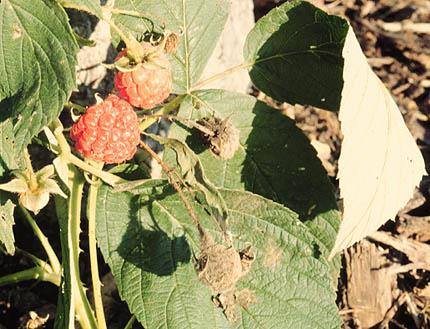
Cause
Gray Mold (Botrytis cinerea), a fungal disease spread by wind and rain.
Treatment
Maintain proper plant health. Also clean up all crop debris, and thin canes annually. Avoid excessive irrigation, especially in cool conditions, and avoid wounding fruit during harvest. No fungicides are labelled for this disease.
Small, seedy, dry, or pitted berries
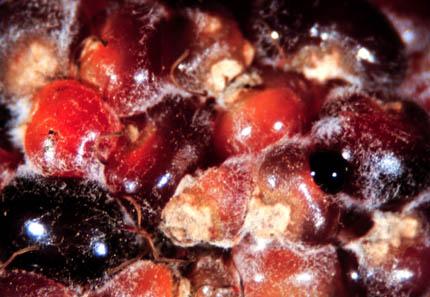
Cause
Anthracnose (Elsinoe veneta), a fungal disease. Leaves, stems, and berries may all be affected. Anthracnose outbreaks are more common during wet or rainy conditions.
Treatment
Plant resistant varieties whenever possible. Prune disease canes out. Spray with lime sulfur fungicides in early spring when plants are still dormant. After bud break switch to copper-based fungicides as necessary.
Small,soft-bodied, white insect on the fruit
Cause
The Raspberry Fruit Worm (Byturus unicolor), the larva of an adult beetle.
Treatment
Damage is rarely severe and normally not control is necessary. Remove affected fruit by hand. Chemical control is usually not necessary.
Small, black bettled with four yellow spots along the back of fruit
Cause
Picnic Beetles (Glischrochilus quadrisignatus). Adult beetles are usually only attracted to overripe or decaying fruit.
Treatment
Clean up fallen or damaged fruit to avoid attracting beetles. Chemical controls will not work, instead the underlying unsanitary conditions should be dealt with.
Leaf Problems
Orange, powdery growth on the underside of leaves
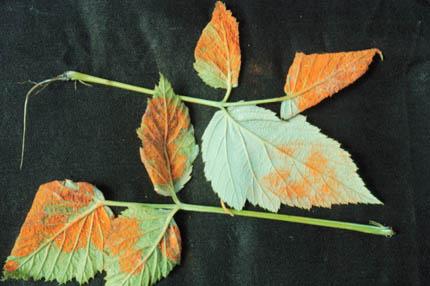
Cause
One of several Orange Rust fungal diseases (Arthuriomyces peckianus, Gymnoconia nitens, Phragmidum rubi-idaei). Rusts are spread by rain and wind, the fungus overwinters in crop debris. Fruit is rarely affected.
Treatment
Plant resistant varieties whenever possible. Spray with lime sulfur fungicides in early spring when plants are still dormant. After bud break switch to copper-based fungicides as necessary.
Misshapen leaves or leaves with ring spots or mosaic patterns
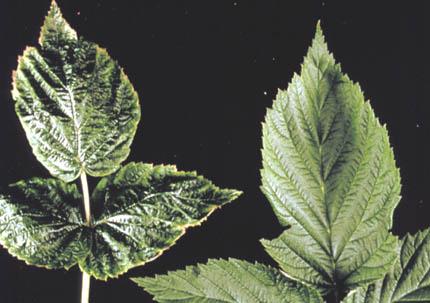
Cause
Viruses. Both leaves and fruit can be affected. Viruses are spread by various insects and nematodes.
Treatment
Plant resistant varieties, and only plant in beds where raspberries were not previously grown. Control weeds adjacent to crop, and eliminate crop debris. Thin canes annually and maintain proper plant health.
Circular leaf spots
Causes
Anthracnose (Elsinoe veneta), a fungal disease. Leaves, stems, and berries may all be affected. Anthracnose outbreaks are more common during wet or rainy conditions.
or
Raspberry Leaf Spot (Sphaerulina rubi), a fungal disease spread by wind and rain. Only leaves are affected.
Treatment
Plant resistant varieties whenever possible. Prune disease canes out. Spray with lime sulfur fungicides in early spring when plants are still dormant. After bud break switch to copper-based fungicides as necessary.
Cane and Crown Problems
Double rows of insect holes near stem tips accompanied by wilting
Cause
Raspberry Cane Borer (Oberea bimaculata), a longhorn beetle. Damage is cause by the adult beetle laying eggs within the cane and subsequent feeding by the larva. Adult beetles are 1/2 inch long, black with yellow stripes on the wings, and a yellow midsection behind the head with two black spots.
Treatment
Remove damaged canes.
Swollen cane areas
Cause
The Redneck Cane Borer (Agrilus ruficollis), a beetle. Damage is cause by the adult beetle laying eggs within the cane and subsequent feeding by the larva. Adult beetles are 1/2 inch long, metallic blue/black with a copper-colored midsection.
Treatment
Remove damaged canes.
Wilting and severed cane tips
Cause
The Raspberry Cane Maggot (Pegomya rubivora), a small gray fly. Damage is caused by the fly larva feeding within the cane, often girdling the stem causing broken tips which appear cut.
Treatment
Remove damaged canes.
Wilting canes with prematurely red leaves
Cause
The Raspberry Crown Borer (Pennisetia marginata), a clear-winged moth which resembles a wasp. Damaged is caused by the moth larva feeding within the base of the cane near the root zone.
Treatment
Remove damaged canes below the crown. For persistent problems remove the entire plant, or spray the base of plants with a labelled pesticide, twice a year, in spring and fall.
Small, sunken spots on canes
Cause
Anthracnose (Elsinoe veneta), a fungal disease. Leaves, stems, and berries may all be affected. Anthracnose outbreaks are more common during wet or rainy conditions.
Treatment
Plant resistant varieties whenever possible. Prune disease canes out. Spray with lime sulfur fungicides in early spring when plants are still dormant. After bud break switch to copper-based fungicides as necessary.
Large brown or gray lesions near wounds
Cause
Cane Blight (Leptosphaeria coniothyrium), a fungal disease spread by rain and cane wounding.
Treatment
Maintain proper plant health, remove crop debris, and thin plants annually. Remove diseased canes and apply lime sulfur in spring while plants are still dormant.
Lesions at nodes along the cane
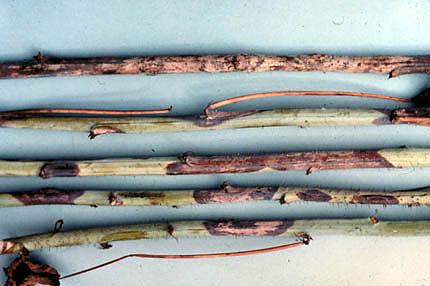
Cause
Spur Blight (Didymella applanata), a fungal disease.
Treatment
Maintain proper plant health, remove crop debris, and thin plants annually. Remove diseased canes and apply lime sulfur in spring while plants are still dormant.